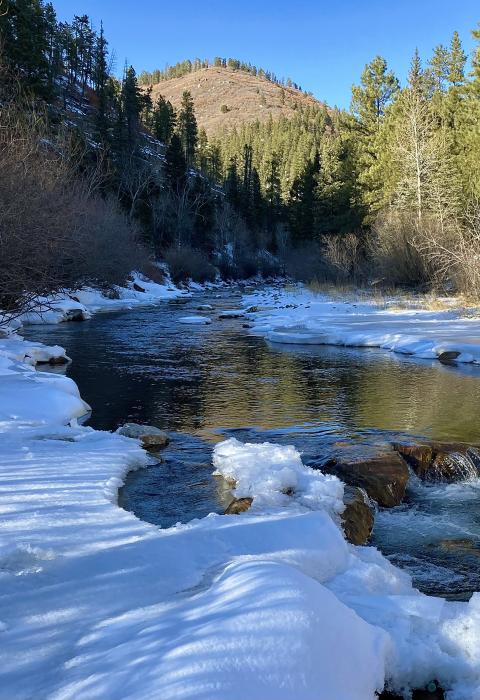Pecos River
New Mexico
The Pecos River, famous in the folklore of the frontier, flows out of the Pecos Wilderness, through rugged granite canyons and waterfalls, and passes small, high-mountain meadows. The wild and scenic river corridor has been a popular recreation setting for many decades. Its popularity continues to increase, because it provides a cool, forested environment and waterway within the arid southwest; it also offers beautiful scenery and high-quality fishing. Some of the most popular recreation activities are hiking, camping, backpacking, hunting, and fishing. The wild segment is entirely in the Pecos Wilderness and provides opportunities for remote, primitive activities. The recreational segment is located along State Highway 63 and offers a range of day and overnight activities from Terrero to Cowles.
Designated Reach
June 6, 1990. From its headwaters to the townsite of Terrerro.
Outstandingly Remarkable Values
Culture
The river was designated for several cultural/ historic values; for instance, there are those associated with the historic home site of George Beatty, famed trapper, prospector, and mountain man. Also, prehistoric use during the Paleo-Indian, Archaic, Basketmaker and Puebloan periods likely involved hunting, fishing, gathering herbs and other plants, and some farming, all adding to the cultural context of the corridor.
History
The area has a very rich history. As early as 1600, Spanish explorers began scouting the upper Pecos River valley for mineral wealth. With the coming of more permanent European and Hispanic settlers in the late 18th and early 19th centuries, the area saw increased use for grazing, logging, hunting, trapping, and mining. Most historic sites recorded in the area lie outside the wilderness boundary and consist of trash scatters with or without structural remains dating to the late 19th and early 20th centuries. Adding to the historic values of the area are early 20th century acequias, cemeteries, sawmills, cabins, and campground structures built by the Civilian Conservation Corps (CCC).
Recreation
The Pecos River has long been a recreational destination for visitors from the region, as well as from around the country. While the Pecos Wilderness adds value to the designation, most visitors come simply to enjoy the water. The river is regarded as one of the state’s most popular trout fishing streams. Local users center their recreation activities on multi-generational family gatherings near the river. In the summer, the river provides relief for visitors coming from the hot, dry environment typical of the southwestern United States. Use is particularly high during this period, with visitors often staying for days or weeks.
Popular activities along the entire designated corridor include hiking, camping, backpacking, horseback riding, hunting, fishing, water play, photography, and sightseeing. Opportunities abound for remote, primitive activities in the wild segment, while the recreational segment offers a range of day and overnight activities from Terrero to Cowles for visitors seeking more developed, less isolated settings that are accessible by automobile.
Scenery
Scenic values for which the river was designated include rugged canyons, waterfalls, and high mountain meadows. Dramatic landscapes of pine and spruce forests—interspersed with aspen patches, high cliffs and rock outcrops, mountain meadows of multi-colored wildflowers, and clear water cascading through the narrow valley—have attracted people to the area for many years. In the autumn, the aspen turns a vivid golden yellow. Panoramic views are revealed near the headwaters of the Pecos River. In the wild segment, the river begins as a high mountain stream, later becoming an array of shallow rapids, churning eddies, and multiple cascades. Pecos Falls is an attractive waterfall and destination for many visitors. In the recreational segment, the meandering water through the canyon provides a unique feature in contrast with the arid plains to the east and south. The few structures in the Beattys Flat area and cabins within the corridor are rustic and blend well with the landscape.

